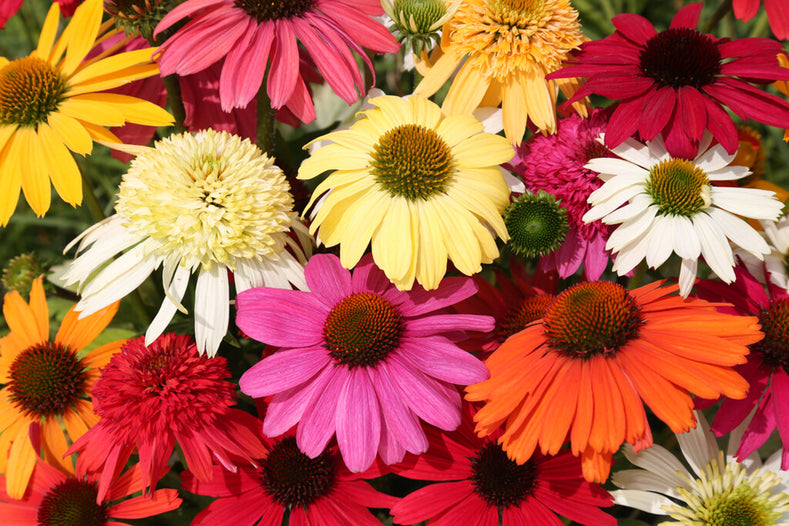How to Plant, Grow, and Care for Coneflowers
Echinacea, also known as coneflowers, are a popular perennial for midsummer blooms. Learn how to plant coneflowers the right way and get more growing tips here.
About Coneflowers
Coneflowers are a popular wildflower native to the eastern and central United States, extending from Colorado south to Texas and north to the Great Lakes. They bloom from midsummer all the way through fall frost. The name "coneflower" comes from the flower's raised cone-like center which attracts butterflies and bees. Leave the seed heads after bloom and you'll also attract songbirds such as goldfinches!
The genus name for coneflowers, Echinacea, originates from the Latin word for hedgehog - echinus, because of the plant’s thorny lower stem which can serve to ward off deer. Another noteworthy mention in the history of Echinacea was its use for medicinal purposes by the Plains Native Americans. They brewed the roots of the popular Purple Coneflower (E. purpurea) as a medicinal cure to treat colds, coughs, and infections.
The purple coneflower (Echinacea purpurea) is the most common and readily available variety of this striking plant. As its name suggests, it has long light purple petals that droop down from its center cone.
Check out our new collection of colorful Echinacea varieties and choose your favorite for your summer garden.

PLANTING
Coneflowers prefer full sun and well-draining soil. They are drought-tolerant and can grow in poor soil, but the results may vary. Dig a hole and set the plant so that its root ball is level with the soil surface. Fill in to the top of the root ball, space plants one to three feet apart depending on size at maturity and water thoroughly. Spread thin layers of compost then mulch on top of the soil surface to help keep plants moist and prevent weeds.
GROWING
Coneflowers are drought tolerant, but new plants need water occasionally, and more often if the spring season is especially dry. They seldom need fertilizer. To delay blooming until fall and promote compact growth, you can cut back the stems by about a foot when the plants start blooming. For staggered bloom heights and times, cut only a few stems. In late summer, you might spot some wasp like soldier beetles. These are beneficial as they feed on insect eggs and larvae, and pollinate the plants. In colder areas, spread some light mulch during late fall to help protect the roots from winter damage. Cut back stems to soil level once they wither, or after the first frost. This will help promote healthy new growth in spring. If you wish to divide or transplant coneflowers, you can do so in spring or fall.
Growing Coneflowers in Pots
Coneflowers are often planted in the ground as perennials, however they can be grown in containers as long as the pot is large enough to accommodate their taproot.
Use containers of 2-3 gallons or a larger size, with drainage holes. Line the bottom of the pots with broken stones for drainage. Securely fill the container half way with potting soil and tamp it down. Plant the root system an inch beneath the edge of the holder, spreading out its roots. Add in dirt slowly until flush with the top layer of the root ball, then compress slightly. Douse copiously at ground level when the soil is dry to touch. Fertilize every few weeks using a water-soluble 10-10-10 element. Cut off flowers nearer to their base for sustained bloomage. To endure wintertime, trim plants down to the soil level when plant development eases off in fall weather. Transfer to a chilly (40º - 50ºF) region that has nominal to intermediate indirect light. Inspect earth every couple goes and mitigate sprinkling lightly when the top three inches are dried up. When new growth appears in spring, move it to a brighter, warmer (60º - 70ºF) area as this action helps preparatory work for outdoor living during spring and summertime seasons. Avoid irrigating foliage from above as it can induce fungal growth on leaves; instead, try drenching at soil plane level. Utilize an insecticidal soap or neem oil solution spray if any aphids or bugs turn up. Every 3 to 4 years in spring once new growth commences, segment and rehome echinacea crops.

Deadheading Coneflowers
Deadheading coneflowers is a matter of preference. If you deadhead right after the flower fades, you prolong blooming and prevent reseeding. However, if you can wait until late winter, your bird visitors, especially goldfinch, will enjoy those seedhead. Coneflowers are well known for self-seeding so if you keep them welcoming to pollinators, you'll have them blooming in multiple places in the garden, attracting more bees and butterflies.
Do Coneflowers Spread?
Echinacea not an aggressive plant, but it will naturally self-seed and spread, which you can encourage if you wait to cut back until late winter. If you would prefer to prevent this, simply deadhead the flowers right after they fade. Keep in mind that hybrid varieties will not self sow as most are sterile, which means they do not produce viable seed.
Harvesting Coneflowers
When harvesting flowers for arrangements, be sure to cut the blooms that are in the process of opening. These flowers will typically last 5 to 7 days in a vase. Additionally, leave some of the spent blooms on the plant to allow birds to consume the seeds throughout the fall and winter. Finally, you may also want to consider harvesting some flowers for drying and use in herbal teas.

